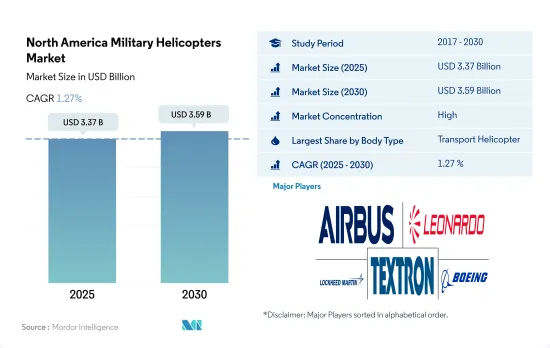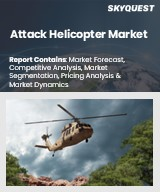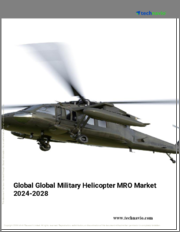
|
시장보고서
상품코드
1693571
북미의 군용 헬리콥터 시장 : 점유율 분석, 산업 동향, 성장 예측(2025-2030년)North America Military Helicopters - Market Share Analysis, Industry Trends & Statistics, Growth Forecasts (2025 - 2030) |
||||||
북미의 군용 헬리콥터 시장 규모는 2025년에 33억 7,000만 달러, 2030년에는 35억 9,000만 달러에 이르고, 예측 기간(2025-2030년)의 CAGR은 1.27%를 나타낼 전망입니다.

지정학적 과제와 방위 예산 증가가 로터 크래프트 시장 성장 촉진요인
- 북미 전체의 국방비 증가는 군용 헬리콥터 시장에 큰 영향을 미칩니다. 각국 정부는 헬리콥터 업그레이드 등 군사력 근대화에 상당한 예산을 부과하고 있습니다. 전쟁의 성격이 진화함에 따라, 국방비는 최신의 어비오닉스, 센서, 무기를 장착한 최첨단 헬리콥터의 획득을 향해 있습니다. 북미의 국방비는 2021년부터 약 1% 급증하고 2022년에는 9,040억 달러에 달했습니다.
- 게다가 미국, 캐나다, 멕시코는 많은 지정학적 과제에 직면해 대테러 작전을 실시했습니다. 2022년 기준으로, 북미 지역의 전체 로터크래프트 운용 대수 중 미국이 92%를 차지했으며, 캐나다가 2%, 멕시코가 3%, 그 밖의 중동 및 아프리카가 3%를 나타낼 전망입니다. 가장 많이 조달된 헬리콥터 모델 중 일부는 824대의 AH-64 아파치 공격 헬리콥터와 513기 이상 H145(UH-72A/B) 383기, S-70/EH/H/MH/UH-60 2,312기, MV-22 289기, S-70/MH-60R/S 489기입니다.
- 국경 경비를 개선하고 최첨단 무기와 기술을 구입하기 위해 이 지역의 일부 국가는 군사 예산을 늘리고 있으며, 이는 미래의 군용 로터 크래프트 항공기 조달 확대에 도움이 될 수 있습니다. CH-47 치누크, UH-60 블랙호크, CH-53K, AH-1Z, MH-139A를 포함한 119대의 로터 크래프트 항공기 조달을 계획하고 있습니다.멕시코 정부는 멕시코 공군을 위해 11대의 헬리콥터(H225M 4대와 UH-60M 7대)를 주문했습니다. 이러한 발전의 결과로 이 지역 국가들은 588기의 로터크래프트를 인도받을 것으로 예상됩니다.
국방예산 증가와 지정학적 분쟁이 이 지역의 헬리콥터 조달 수요를 견인
- 북미 국가, 특히 미국은 지정 학적 분쟁에 대항하기 위해 선진적인 헬리콥터를 신속하게 개발해 왔습니다. 2022년, 이 지역의 국방비는 총액 9,120억 달러에 이르렀습니다.
- 군사 예산이 증가함에 따라 이 지역의 각국은 향후 군용 로터 크래프트기의 조달 확대를 촉진할 가능성이 있습니다.
- 2022년 현재 북미가 보유한 로터 크래프트기는 전체 세계의 로터 크래프트기 총수의 약 29%를 차지하고 있습니다. 56%가 멀티미션 헬리콥터, 39%가 수송용 헬리콥터, 31%가 그 밖의 헬리콥터입니다.
- 현재 진행중의 조달과 근대화 계획에 의해 미국은 계속해서 시장을 리드해, 신형 로터 크래프트기의 큰 수요를 낳을 가능성이 있습니다.
북미 군용 헬리콥터 시장 동향
지정학적 위협이 이 지역의 방위비 증가의 주인
- 2022년 미국은 세계 국방지출의 39%를 차지하는 군사지출은 2022년에 8,770억 달러(0.7%) 증가했습니다. 연도 예산 요구 금액은 약 202억 달러, 2022년 요구 금액에서 11.7% 증가한 약 1,940억 달러로 추정되었습니다. 2023 회계연도 예산에는 F-35 61기, F-15EX 24기, 병참 지원기 79기, 로터 크래프트기 119기, UAV/UAS 12기의 구입이 포함됩니다.
- 지난 몇 년간 캐나다는 안전보장 우려의 고조에 대처하고 군비를 근대화하기 위해 국방 지출을 늘리겠다는 의지도 보여 왔습니다. 캐나다의 2022년 군사비는 269억 달러로 전년 대비 3.0% 증가했습니다. 정부 지출 전체 중 군사비에 할당된 비율은 1.2%입니다.
- 멕시코에서는 범죄 행위에 대항하기 위한 군사력의 사용이 서브리전에서의 군사 지출의 주요 원동력이 되고 있습니다. 2021년에 비해 9.7% 감소했습니다. 국가 경비대에의 지출은 2021년에 35% 증가해, 군사비 전체의 16%를 차지했습니다.
함대의 근대화와 항공기의 근대화 요구 증가가 북미의 촉진요인
- 2022년 12월 현재 북미에서는 13,676기의 항공기와 헬리콥터가 활약하고 있습니다. 미국은 이 지역과 전 세계에서 가장 큰 군용기를 보유하고 있으며 만 3,300기가 운용되고 있습니다. 이 함대의 상당한 부분은 전투 헬리콥터(42%)와 전투기(21%)로 차지되고 있습니다. 반면, 훈련기와 헬리콥터는 20%를 차지하고, 수송용 비행기는 7%에 불과합니다.
- 2022년 말까지 캐나다는 약 356대의 항공기와 로터 크래프트기를 보유했습니다. 이 총 356대의 항공기 중에서 가장 많이 조달된 항공기는 훈련용 항공기/헬리콥터로 132대를 차지하며, 그 뒤를 이어 전투 헬리콥터 120대, 전투 항공기 63대, 수송 항공기 28대, 특수 임무 항공기 27대, 유조선 항공기 6대가 있습니다. 2025년에 신형기 조달을 시작할 예정입니다. 멕시코는 2022년 12월 현재 468기의 항공기를 보유하고 있습니다. 투투 헬리콥터 157기, 수송기 46기, 특수 임무기 25기, 전투기 36기로 되어 있습니다.
북미 군용 헬리콥터 산업 개요
북미의 군용 헬리콥터 시장은 상당히 통합되어 있으며 상위 5개사에서 99.96%를 차지하고 있습니다.이 시장의 주요 기업은 Airbus SE, Leonardo SpA, Lockheed Martin Corporation, Textron Inc., The Boeing Company 등입니다.
기타 혜택
- 엑셀 형식 시장 예측(ME) 시트
- 3개월의 애널리스트 서포트
목차
제1장 주요 요약과 주요 조사 결과
제2장 보고서 제안
제3장 소개
- 조사의 전제조건과 시장 정의
- 조사 범위
- 조사 방법
제4장 주요 산업 동향
- 국내총생산
- 액티브 플릿 데이터
- 국방 지출
- 규제 프레임워크
- 밸류체인 분석
제5장 시장 세분화
- 기체 유형
- 멀티미션 헬리콥터
- 수송용 헬리콥터
- 기타
- 국가
- 캐나다
- 멕시코
- 미국
- 기타 북미
제6장 경쟁 구도
- 주요 전략 동향
- 시장 점유율 분석
- 기업 상황
- 기업 프로파일
- Airbus SE
- Leonardo SpA
- Lockheed Martin Corporation
- MD Helicopters LLC.
- Textron Inc.
- The Boeing Company
제7장 CEO에 대한 주요 전략적 질문
제8장 부록
- 세계 개요
- 개요
- Five Forces 분석 프레임워크
- 세계의 밸류체인 분석
- 시장 역학(DROs)
- 정보원과 참고문헌
- 도표 일람
- 주요 인사이트
- 데이터 팩
- 용어집
The North America Military Helicopters Market size is estimated at 3.37 billion USD in 2025, and is expected to reach 3.59 billion USD by 2030, growing at a CAGR of 1.27% during the forecast period (2025-2030).

Geopolitical challenges and rising defense budgets are the driving factors of the rotorcraft market
- The increase in defense spending across North America has significantly impacted the military helicopter market. Governments are allocating substantial resources to modernize their military capabilities, including upgrading helicopter fleets. As the nature of warfare evolves, defense spending is being directed toward acquiring cutting-edge helicopters equipped with the latest avionics, sensors, and weaponry. The defense expenditure of North America surged around 1% from 2021 to USD 904 billion in 2022.
- Additionally, the United States, Canada, and Mexico face numerous geopolitical challenges and perform counter-terrorism operations. Hence, these countries seek to enhance their aerial capabilities to respond effectively to these threats, which has contributed to the demand for military helicopters. As of 2022, in terms of the active fleet, the US accounted for 92% of the total rotorcraft in North America, while Canada, Mexico, and the Rest of North America accounted for 2%, 3%, and 3%, respectively. Some of the most procured helicopter models are 824 AH-64 Apache attack helicopters and over 513 CH-47D/F/MH-47G, 383 H145 (UH-72A/B), 2,312 S-70/EH/HH/MH/UH-60, 289 MV-22, and 489 S-70/MH-60R/S.
- To improve border security and buy cutting-edge weaponry and technologies, several countries in the region have increased their military budget, which may aid the future expansion of military rotorcraft procurement. For instance, in 2023, the United States planned to procure 119 rotorcraft, including CH-47 Chinook, UH-60 Black Hawk, CH-53K, AH-1Z, and MH-139A. The Mexican government ordered 11 helicopters (four H225M and seven UH-60M) for its Mexican Air Force. As a result of these advancements, the countries in the region are expected to take delivery of 588 rotorcraft.
Rising defense budgets and geopolitical conflicts are driving the demand for helicopter procurement in the region
- Countries in North America, particularly the United States, have been among the first to develop advanced helicopters to counter geopolitical conflicts. Nearly 94% of the military expenditures in the Americas region come from North America. In 2022, the region's defense expenditure totaled USD 912 billion. North America's military expenditures were largely accounted for by the United States (96%), followed by Canada and Mexico, with 3% and 1%, respectively.
- With increased military budgets, various countries in the region may facilitate the expansion of military rotorcraft procurement in the future. In 2023, the United States plans to purchase 119 rotorcraft, including the CH-47 Chinook, the UH-60 Black Hawk, the CH-53K, and the AH-1Z. The Mexican government ordered 11 helicopters (four H225M and seven UH-60M) for the Mexican Air Force.
- As of 2022, in terms of active fleet size, North America held approximately 29% of the total rotorcraft worldwide. Out of the entire region, the United States stood first, operating 92% of rotorcraft, of which 38% are multi-mission helicopters, 58% are transport helicopters, and 4% are other helicopters. The country was followed by Mexico, which operates 3% of fixed-wing aircraft, of which 56% are multi-mission helicopters, 39% are transport helicopters, and 31% are other helicopters. Canada followed Mexico, operating 2% of fixed-wing aircraft, of which 64% are multi-mission helicopters, 21% are transport helicopters, and 16% are other helicopters.
- With the ongoing procurements and modernization plans, the United States may continue to lead the market and generate significant demand for new rotorcraft. During the forecast period, a total of 588 aircraft are expected to be procured by the country.
North America Military Helicopters Market Trends
Geopolitical threats are the main reason behind the increase in defense spending in the region
- In 2022, the US accounted for 39% of global defense spending military spending increased by USD 877 billion in 2022, or 0.7%. The total includes military assistance to Ukraine, estimated at USD 19.9 billion. In 2022, the US released the Department of the Air Force budget, which outlined that for FY 2023, the budget request is approximately USD 194.0 billion, a USD 20.2 billion or 11.7% increase from the FY 2022 request. This funding includes aircraft R&D, aircraft acquisition, initial spares, and aircraft support equipment. The funding for FY 2023 includes the purchase of 61 F-35, 24 F-15EX, 79 logistics and support aircraft, 119 rotary wing aircraft, and 12 UAV/UAS.
- Over the past few years, Canada also has demonstrated a commitment to increase defense spending to address growing security concerns and modernize its military equipment. The country recognizes the need to adapt to emerging threats, such as cyber warfare and asymmetric challenges, while maintaining conventional defense capabilities. Canada spent USD 26.9 billion on its military in 2022, which was 3.0 % higher than the previous year. Out of the total government spending, the country has allocated 1.2% of its share to the military. As per the Budget 2022, the announcement government will offer more than USD 8 billion for new funding to Canada's national defense over the next five years.
- In Mexico, the use of military forces to combat criminal activity remains the primary driver of military spending in the sub-region. Mexico's defense spending in 2022 was USD 8.5 billion, a decrease of 9.7% compared to 2021. Spending on the National Guard increased by 35% in 2021, accounting for 16% of total military spending. The country's defense expenditure was 0.6% of its GDP in 2022.
Fleet modernization and the rising need for modernization of aircraft are the driving factors in North America
- As of December 2022, North America had an active fleet of 13,676 aircraft and helicopters. Competition in technology is accelerating between China and the United States as both countries are increasingly focused on the R&D of emerging technologies to prepare for future warfare. The United States has the biggest fleet of military aircraft in the region and globally, with a total of 13,300 operational fleets. A considerable chunk of this fleet is made up of combat helicopters (42%) and combat planes (21%). In contrast, training planes and helicopters account for 20%, while transport planes make up only 7%. Meanwhile, tankers and special mission aircraft each represent 5% of the fleet.
- By the end of 2022, Canada had an active fleet of about 356 aircraft and rotorcraft. Of these total 356 aircraft, the most procured fleet is training aircraft/helicopters, accounting for 132, followed by 120 combat helicopters, 63 combat aircraft, 28 transport aircraft, 27 special mission aircraft, and 6 tanker aircraft. Canada has selected F-35s to replace its CF-18 fighter jets, which are scheduled to retire by 2032. If the F-35 deal is finalized, Canada plans to start procuring the new jets in 2025. Mexico had an active fleet of 468 aircraft as of December 2022. Of these total 468 aircraft, the most procured fleet is training aircraft, and helicopters accounted for 203 aircraft, followed by 157 combat helicopters, 46 transport aircraft, 25 special mission aircraft, and 36 combat aircraft. As transnational criminal organizations and drug cartels largely occupy the country, the country utilizes military helicopters to fight drug traffickers.
North America Military Helicopters Industry Overview
The North America Military Helicopters Market is fairly consolidated, with the top five companies occupying 99.96%. The major players in this market are Airbus SE, Leonardo S.p.A, Lockheed Martin Corporation, Textron Inc. and The Boeing Company (sorted alphabetically).
Additional Benefits:
- The market estimate (ME) sheet in Excel format
- 3 months of analyst support
TABLE OF CONTENTS
1 EXECUTIVE SUMMARY & KEY FINDINGS
2 REPORT OFFERS
3 INTRODUCTION
- 3.1 Study Assumptions & Market Definition
- 3.2 Scope of the Study
- 3.3 Research Methodology
4 KEY INDUSTRY TRENDS
- 4.1 Gross Domestic Product
- 4.2 Active Fleet Data
- 4.3 Defense Spending
- 4.4 Regulatory Framework
- 4.5 Value Chain Analysis
5 MARKET SEGMENTATION (includes market size in Value in USD and Volume, Forecasts up to 2030 and analysis of growth prospects)
- 5.1 Body Type
- 5.1.1 Multi-Mission Helicopter
- 5.1.2 Transport Helicopter
- 5.1.3 Others
- 5.2 Country
- 5.2.1 Canada
- 5.2.2 Mexico
- 5.2.3 United States
- 5.2.4 Rest of North America
6 COMPETITIVE LANDSCAPE
- 6.1 Key Strategic Moves
- 6.2 Market Share Analysis
- 6.3 Company Landscape
- 6.4 Company Profiles
- 6.4.1 Airbus SE
- 6.4.2 Leonardo S.p.A
- 6.4.3 Lockheed Martin Corporation
- 6.4.4 MD Helicopters LLC.
- 6.4.5 Textron Inc.
- 6.4.6 The Boeing Company
7 KEY STRATEGIC QUESTIONS FOR AVIATION CEOS
8 APPENDIX
- 8.1 Global Overview
- 8.1.1 Overview
- 8.1.2 Porter's Five Forces Framework
- 8.1.3 Global Value Chain Analysis
- 8.1.4 Market Dynamics (DROs)
- 8.2 Sources & References
- 8.3 List of Tables & Figures
- 8.4 Primary Insights
- 8.5 Data Pack
- 8.6 Glossary of Terms

















